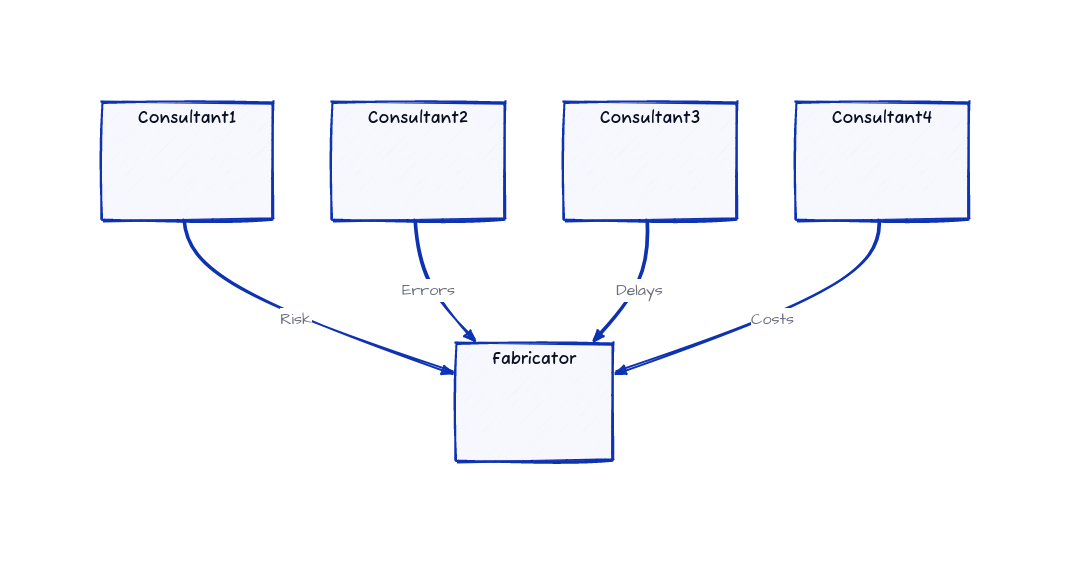Hidden Costs in Construction
Summary
There are flaws in the building and construction process:
- “moral hazards”, which in turn
- increase costs (risks, delays and actual monetary costs).
As a result, the industry is plagued with inefficiency.
This article identifies one aspect of the problem, and proposes a solution.
Costs compound
Consider the adage:
Measure twice, cut once.
Mistakes at the design stage, cost exponentially more on site.
Let’s take a silly example: if a consultant incorrectly engineers a panel: it’s a small mistake, right? But once the panel has been made: that small mistake becomes a very big one: there are guys on the factory/site, crane costs, liquidated damages etc. The costs compound exponentially.
It’s paramount that problems are solved at the design stage. Systems must be designed to incentivise this outcome. Or stated in the negative: the current “Design and Build” model is flawed, and creates a huge moral hazard problem:
Who carries the can?
Let’s elaborate on the concept of moral hazard, using an analogy unrelated to building and construction. Take note of the important point: whoever is best able to mitigate cost and risk, ought to have those risks and costs imputed to them with an invoice.
Question: Johnny gets drunk, and crashes into my car. Who pays?
Answer: Johnny should pay, because he caused the problem. If I had to pay for Johnny’s mistakes / ignorance, what incentive is there for Johnny to take preventative measures?
Who Carries the Can in Construction Projects?
Consultants make mistakes, make changes flippantly, delay important answers, at enormous risk to fabricators, but none to themselves: this is the status quo. Furthermore, they typically drag their feet, are slow to answer RFIs and give approvals.
They’re passing the can on:

If the costs could be returned, it would incentivise consultants to make better designs at the outset:

It can only result in a more efficient industry, because the moral hazard problem would be mitigated.
The Risk Does Not Disappear
Perhaps, it is thought by Head Contractors that if the risk is parcelled off to others, then they disappear. Nothing could be more fallacious. This policy makes about as much sense as passing a hand grenade from your left hand, to your right hand, and thinking that your safe. Such a policy makes sense only if the transferee is better able to manage / mitigate those risks. But the status quo operates completely backwards: risks are passed on to those least able to mitigate them.
As a result: the costs and risks do not disappear, but are concretely transmuted into other forms: delays, poorer build qualities, insolvencies, lack of stability - all of these result from margins being squeezed.
But we do “design and build”!
Some common objections:
-
“Our fees are fixed!” Yes, but this invites the aforementioned moral hazard problem.
-
“No builder in their right mind would want me to pass costs back to them, we charge: e.g. $14K per panel!”.
-
“OMG: I”m going to loose all my clients if I pass on the costs!””
Are you sure? Builders would not want to see which of their consultants are adding risk / delays to their projects? Do you have any evidence to prove this claim? If I’m a builder, and if my consultants are exponential increasing the risk of my projects, I would definitely want that problem to be fixed.
It is true, nobody wants their costs to increase, but if builders saw an invoice + justifications, then they could take mitigating steps - whatever that might be: improving processes, better incentivising staff, developing better tooling:
Johnny, mate, get your act together.
Passing on costs + costs of delays - quantifying them, allows for the “signalling” of costs to occur, nothing screams louder for a solution, than an invoice. It allows for a long-term competitive advantage to be built, with a small short term cost: it is imperative that risks and delays be quantified and passed on. Sweeping them under the rug does not make them disappear.
The Solution
The Quote app makes it easy to document and identify costs, and pass them back up the chain. Doing so via email + excel is cumbesome and inefficient. Now, thanks to cloud computing, costs can be easily documented, and passed back to the person who caused them, almost instantaneously.
Doing so will better incentivise parties, and reduce costs in the long run.
It will be a big win for the industry, and it ought to be implemented. Whoever does so now, will have a big competitive advantage.